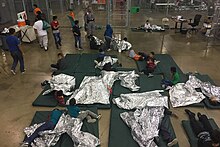Donald Trump

Donald Trump | |
|---|---|
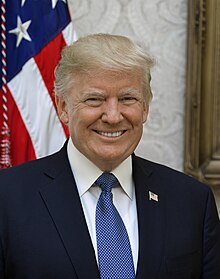 Official portrait, 2017 | |
| President-elect of the United States | |
| Assuming office January 20, 2025 | |
| Vice President | JD Vance (elect) |
| Succeeding | Joe Biden |
| 45th President of the United States | |
| In office January 20, 2017 – January 20, 2021 | |
| Vice President | Mike Pence |
| Preceded by | Barack Obama |
| Succeeded by | Joe Biden |
| Personal details | |
| Born | Donald John Trump June 14, 1946 Queens, New York City, U.S. |
| Political party | Republican (1987–1999, 2009–2011, 2012–present) |
| Other political affiliations |
|
| Spouses | |
| Children | |
| Relatives | Trump family |
| Alma mater | University of Pennsylvania (BS) |
| Occupation | |
| Awards | Full list |
| Signature |  |
| Website | |
| ||
|---|---|---|
| Business and personal 45th and 47th President of the United States Tenure
Impeachments Civil and criminal prosecutions  | ||
Donald John Trump (born June 14, 1946) is an American politician, media personality, and businessman who served as the 45th president of the United States from 2017 to 2021. A member of the Republican Party, he is the president-elect after winning the 2024 presidential election and is scheduled to be inaugurated as the 47th president on January 20, 2025.
Born in New York City, Trump graduated with a bachelor's degree in economics from the University of Pennsylvania in 1968. After becoming president of the family real estate business in 1971, Trump renamed it the Trump Organization and reoriented the company toward building and renovating skyscrapers, hotels, casinos, and golf courses. After a series of business failures in the late 1990s, he launched side ventures, mostly licensing the Trump name. From 2004 to 2015, he produced and hosted the reality television series The Apprentice. He and his businesses have been involved in more than 4,000 legal actions, including six business bankruptcies.
Trump won the 2016 presidential election as the Republican Party nominee, defeating Democratic Party candidate Hillary Clinton despite losing the popular vote,[a] and became the first U.S. president without prior military or government experience. The Mueller investigation later determined that Russia interfered in the 2016 election to help Trump. His campaign positions were described as populist, protectionist, and nationalist. His election and policies sparked numerous protests and led to the creation of a political movement and cult of personality.[b] Trump promoted conspiracy theories and made many false and misleading statements during his campaigns and presidency, to a degree unprecedented in American politics. Many of his comments and actions have been characterized as racially charged, racist, and misogynistic.
In his first term, Trump ordered a travel ban on citizens from several Muslim-majority countries, diverted military funding toward building a wall on the U.S.–Mexico border, and implemented a family separation policy. He rolled back more than 100 environmental policies and regulations and signed the Tax Cuts and Jobs Act of 2017, which cut taxes and eliminated the individual mandate penalty of the Affordable Care Act. He appointed Neil Gorsuch, Brett Kavanaugh, and Amy Coney Barrett to the U.S. Supreme Court. He reacted slowly to the COVID-19 pandemic, ignored or contradicted recommendations from health officials, used political pressure to interfere with testing efforts, and spread unverified information about unproven treatments. Trump initiated a trade war with China and withdrew the U.S. from the proposed Trans-Pacific Partnership trade agreement, the Paris Agreement on climate change, and the Iran nuclear deal. He met with North Korean leader Kim Jong Un three times, but made no progress on denuclearization. Scholars and historians rank Trump as one of the worst presidents in American history.
Trump lost the 2020 presidential election to Democrat Joe Biden but refused to concede, falsely claiming widespread electoral fraud and attemping to overturn the results. On January 6, 2021, Trump urged his supporters to march to the U.S. Capitol, which many of them attacked. He is the only U.S. president to have been impeached twice: in 2019 for abuse of power and obstruction of Congress after he pressured Ukraine to investigate Biden, and in 2021 for incitement of insurrection; the Senate acquitted him in both cases. In 2024, a New York jury found him guilty of falsifying business records related to a hush money payment to Stormy Daniels, making him the first U.S. president to be convicted of a felony. Trump faced more felony indictments related to his alleged mishandling of classified documents and interference in the 2020 election, and he was found liable in civil trials for sexual abuse, defamation, and financial fraud.
After leaving office, Trump continued to dominate the Republican Party. He became its nominee again in the 2024 presidential election and defeated Democratic candidate Kamala Harris, winning both the popular and electoral vote. He became the second president in U.S. history after Grover Cleveland to be elected to non-consecutive terms.
Personal life
Early life
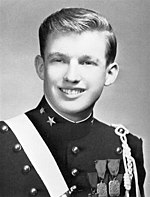
Trump was born on June 14, 1946, at Jamaica Hospital in Queens, New York City,[1] the fourth child of Fred Trump and Mary Anne MacLeod Trump. He grew up with older siblings Maryanne, Fred Jr., and Elizabeth and younger brother Robert in the Jamaica Estates neighborhood of Queens.[2] He attended the private Kew-Forest School through seventh grade[3][4] and New York Military Academy, a private boarding school, from eighth through twelfth grade.[5][4]
After high school, Trump considered studying at the University of Southern California's film school,[6][7] but ended up enrolling at Fordham University in 1964. He attended the liberal arts college at Fordham's Rose Hill campus for two years, before transferring to the Wharton School of the University of Pennsylvania, where he graduated in May 1968 with a Bachelor of Science in economics.[8][9][10] In 2015, Trump's lawyer threatened Trump's colleges, his high school, and the College Board with legal action if they released his academic records.[11]
While in college, Trump obtained four student draft deferments during the Vietnam War.[12] In 1966, he was deemed fit for military service based on a medical examination, and in July 1968, a local draft board classified him as eligible to serve.[13][14][15] In October 1968, he was classified 1-Y, a conditional medical deferment for bone spurs,[13] and in 1972, he was reclassified 4-F, unfit for military service, permanently disqualifying him.[15]
Family
In 1977, Trump married Czech model Ivana Zelníčková.[16] They had three children: Donald Jr. (born 1977), Ivanka (1981), and Eric (1984). The couple divorced in 1990, following Trump's affair with actress Marla Maples.[17] Trump and Maples married in 1993 and divorced in 1999. They have one daughter, Tiffany (born 1993), who was raised by Maples in California.[18] In 2005, Trump married Slovenian model Melania Knauss.[19] They have one son, Barron (born 2006).[20]
Religion
In the 1970s, Trump's parents joined the Marble Collegiate Church, part of the Reformed Church in America.[21][22] He went to Sunday school and was confirmed in 1959 at the First Presbyterian Church in Jamaica, Queens.[21][23] In 2015, he said he was a Presbyterian and attended Marble Collegiate Church; the church said he was not an active member.[23] In 2019, he appointed his personal pastor, televangelist Paula White, to the White House Office of Public Liaison.[24] In 2020, he said he identified as a non-denominational Christian.[25]
Health habits
Trump says he has never drunk alcohol, smoked cigarettes, or used drugs.[26][27] He sleeps about four or five hours a night.[28][29] He has called golfing his "primary form of exercise" but usually does not walk the course.[30] He considers exercise a waste of energy because he believes the body is "like a battery, with a finite amount of energy", which is depleted by exercise.[31][32] In 2015, Trump's campaign released a letter from his longtime personal physician, Harold Bornstein, stating that Trump would "be the healthiest individual ever elected to the presidency".[33] In 2018, Bornstein said Trump had dictated the contents of the letter and that three of Trump's agents had seized his medical records in a February 2017 raid on the doctor's office.[33][34]
Wealth
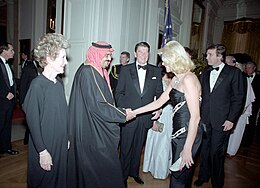
In 1982, Trump made the initial Forbes list of wealthy people for holding a share of his family's estimated $200 million net worth (equivalent to $631 million in 2023).[35] His losses in the 1980s dropped him from the list between 1990 and 1995.[36] After filing the mandatory financial disclosure report with the FEC in July 2015, he announced a net worth of about $10 billion. Records released by the FEC showed at least $1.4 billion in assets and $265 million in liabilities.[37] Forbes estimated his net worth dropped by $1.4 billion between 2015 and 2018.[38] In their 2024 billionaires ranking, Trump's net worth was estimated to be $2.3 billion (1,438th in the world).[39]
In 2018, journalist Jonathan Greenberg reported that Trump had called him in 1984 pretending to be a fictional Trump Organization official named "John Barron". Greenberg said that, to get a higher ranking on the Forbes 400 list of wealthy Americans, Trump, speaking as "Barron", falsely asserted that Donald Trump owned more than 90 percent of his father's business. Greenberg also wrote that Forbes had vastly overestimated Trump's wealth and wrongly included him on the 1982, 1983, and 1984 rankings.[40]
Trump has often said he began his career with "a small loan of a million dollars" from his father and that he had to pay it back with interest.[41] He was a millionaire by age eight, borrowed at least $60 million from his father, largely failed to repay those loans, and received another $413 million (2018 dollars adjusted for inflation) from his father's company.[42][43] In 2018, he and his family were reported to have committed tax fraud, and the New York State Department of Taxation and Finance started an investigation.[43] His investments underperformed the stock and New York property markets.[44][45] Forbes estimated in October 2018 that his net worth declined from $4.5 billion in 2015 to $3.1 billion in 2017 and his product-licensing income from $23 million to $3 million.[46]
Trump's tax returns from 1985 to 1994 show net losses totaling $1.17 billion. The losses were higher than those of almost every other American taxpayer. The losses in 1990 and 1991, more than $250 million each year, were more than double those of the nearest taxpayers. In 1995, his reported losses were $915.7 million (equivalent to $1.83 billion in 2023).[47][48][35]
In 2020, The New York Times obtained Trump's tax information extending over two decades. Its reporters found that Trump reported losses of hundreds of millions of dollars. Since 2010 he had also failed to pay back $287 million in loans. During the 15 years prior to 2020, Trump, using tax credits for business losses, paid no income taxes in 10 of those years and $750 each in 2016 and 2017. He balanced his businesses' losses by selling and borrowing against assets, including a $100 million mortgage on Trump Tower (refinanced in 2022) and the liquidation of over $200 million in stocks and bonds. He personally guaranteed $421 million in debt, most of which is due by 2024.[49]
As of October 2021[update], Trump had over $1.3 billion in debts, much of which is secured by his assets.[50] In 2020, he owed $640 million to banks and trust organizations, including Bank of China, Deutsche Bank, and UBS, and approximately $450 million to unknown creditors. The value of his assets exceeds his debt.[51]
Business career
Real estate

Starting in 1968, Trump was employed at his father's real estate company, Trump Management, which owned racially segregated middle-class rental housing in New York City's outer boroughs.[53][54] In 1971, his father made him president of the company and he began using the Trump Organization as an umbrella brand.[55] Between 1991 and 2009, he filed for Chapter 11 bankruptcy protection for six of his businesses: the Plaza Hotel in Manhattan, the casinos in Atlantic City, New Jersey, and the Trump Hotels & Casino Resorts company.[56]
Manhattan and Chicago developments
Trump attracted public attention in 1978 with the launch of his family's first Manhattan venture, the renovation of the derelict Commodore Hotel, adjacent to Grand Central Terminal.[57] The financing was facilitated by a $400 million city property tax abatement arranged for Trump by his father who also, jointly with Hyatt, guaranteed a $70 million bank construction loan.[54][58] The hotel reopened in 1980 as the Grand Hyatt Hotel,[59] and that same year, Trump obtained rights to develop Trump Tower, a mixed-use skyscraper in Midtown Manhattan.[60] The building houses the headquarters of the Trump Corporation and Trump's PAC and was Trump's primary residence until 2019.[61][62]
In 1988, Trump acquired the Plaza Hotel with a loan from a consortium of sixteen banks.[63] The hotel filed for bankruptcy protection in 1992, and a reorganization plan was approved a month later, with the banks taking control of the property.[64] In 1995, Trump defaulted on over $3 billion of bank loans, and the lenders seized the Plaza Hotel along with most of his other properties in a "vast and humiliating restructuring" that allowed Trump to avoid personal bankruptcy.[65][66] The lead bank's attorney said of the banks' decision that they "all agreed that he'd be better alive than dead."[65]
In 1996, Trump acquired and renovated the mostly vacant 71-story skyscraper at 40 Wall Street, later rebranded as the Trump Building.[67] In the early 1990s, Trump won the right to develop a 70-acre (28 ha) tract in the Lincoln Square neighborhood near the Hudson River. Struggling with debt from other ventures in 1994, Trump sold most of his interest in the project to Asian investors, who financed the project's completion, Riverside South.[68]
Trump's last major construction project was the 92-story mixed-use Trump International Hotel and Tower (Chicago) which opened in 2008. In 2024, the New York Times and ProPublica reported that the Internal Revenue Service was investigating whether Trump had twice written off losses incurred through construction cost overruns and lagging sales of residential units in the building Trump had declared to be worthless on his 2008 tax return.[69][70]
Atlantic City casinos

In 1984, Trump opened Harrah's at Trump Plaza, a hotel and casino, with financing and management help from the Holiday Corporation.[71] It was unprofitable, and Trump paid Holiday $70 million in May 1986 to take sole control.[72] In 1985, Trump bought the unopened Atlantic City Hilton Hotel and renamed it Trump Castle.[73] Both casinos filed for Chapter 11 bankruptcy protection in 1992.[74]
Trump bought a third Atlantic City venue in 1988, the Trump Taj Mahal. It was financed with $675 million in junk bonds and completed for $1.1 billion, opening in April 1990.[75][76] Trump filed for Chapter 11 bankruptcy protection in 1991. Under the provisions of the restructuring agreement, Trump gave up half his initial stake and personally guaranteed future performance.[77] To reduce his $900 million of personal debt, he sold the Trump Shuttle airline; his megayacht, the Trump Princess, which had been leased to his casinos and kept docked; and other businesses.[78]
In 1995, Trump founded Trump Hotels & Casino Resorts (THCR), which assumed ownership of the Trump Plaza.[79] THCR purchased the Taj Mahal and the Trump Castle in 1996 and went bankrupt in 2004 and 2009, leaving Trump with 10 percent ownership.[71] He remained chairman until 2009.[80]
Clubs
In 1985, Trump acquired the Mar-a-Lago estate in Palm Beach, Florida.[81] In 1995, he converted the estate into a private club with an initiation fee and annual dues. He continued to use a wing of the house as a private residence.[82] Trump declared the club his primary residence in 2019.[62] The Trump Organization began building and buying golf courses in 1999.[83] It owns fourteen and manages another three Trump-branded courses worldwide.[83][84]
Licensing of the Trump brand
The Trump name has been licensed for consumer products and services, including foodstuffs, apparel, learning courses, and home furnishings.[85][86] According to The Washington Post, there are more than 50 licensing or management deals involving Trump's name, and they have generated at least $59 million in revenue for his companies.[87] By 2018, only two consumer goods companies continued to license his name.[85]
Side ventures
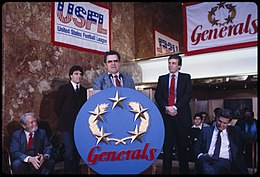
In September 1983, Trump purchased the New Jersey Generals, a team in the United States Football League. After the 1985 season, the league folded, largely due to Trump's attempt to move to a fall schedule (when it would have competed with the NFL for audience) and trying to force a merger with the NFL by bringing an antitrust suit.[88][89]
Trump and his Plaza Hotel hosted several boxing matches at the Atlantic City Convention Hall.[71][90] In 1989 and 1990, Trump lent his name to the Tour de Trump cycling stage race, an attempt to create an American equivalent of European races such as the Tour de France or the Giro d'Italia.[91]
From 1986 to 1988, Trump purchased significant blocks of shares in various public companies while suggesting that he intended to take over the company and then sold his shares for a profit,[47] leading some observers to think he was engaged in greenmail.[92] The New York Times found that Trump initially made millions of dollars in such stock transactions, but "lost most, if not all, of those gains after investors stopped taking his takeover talk seriously".[47]
In 1988, Trump purchased the Eastern Air Lines Shuttle, financing the purchase with $380 million (equivalent to $979 million in 2023)[35] in loans from a syndicate of 22 banks. He renamed the airline Trump Shuttle and operated it until 1992.[93] Trump defaulted on his loans in 1991, and ownership passed to the banks.[94]

In 1992, Trump, his siblings Maryanne, Elizabeth, and Robert, and his cousin John W. Walter, each with a 20 percent share, formed All County Building Supply & Maintenance Corp. The company had no offices and is alleged to have been a shell company for paying the vendors providing services and supplies for Trump's rental units, then billing those services and supplies to Trump Management with markups of 20–50 percent and more. The owners shared the proceeds generated by the markups.[43][95] The increased costs were used to get state approval for increasing the rents of Trump's rent-stabilized units.[43]
From 1996 to 2015, Trump owned all or part of the Miss Universe pageants, including Miss USA and Miss Teen USA.[96][97] Due to disagreements with CBS about scheduling, he took both pageants to NBC in 2002.[98][99] In 2007, Trump received a star on the Hollywood Walk of Fame for his work as producer of Miss Universe.[100] NBC and Univision dropped the pageants in June 2015.[101]
Trump University
In 2004, Trump co-founded Trump University, a company that sold real estate seminars for up to $35,000.[102] After New York State authorities notified the company that its use of "university" violated state law (as it was not an academic institution), its name was changed to the Trump Entrepreneur Initiative in 2010.[103]
In 2013, the State of New York filed a $40 million civil suit against Trump University, alleging that the company made false statements and defrauded consumers.[104] Additionally, two class actions were filed in federal court against Trump and his companies. Internal documents revealed that employees were instructed to use a hard-sell approach, and former employees testified that Trump University had defrauded or lied to its students.[105][106][107] Shortly after he won the 2016 presidential election, Trump agreed to pay a total of $25 million to settle the three cases.[108]
Foundation
The Donald J. Trump Foundation was a private foundation established in 1988.[109][110] From 1987 to 2006, Trump gave his foundation $5.4 million which had been spent by the end of 2006. After donating a total of $65,000 in 2007–2008, he stopped donating any personal funds to the charity,[111] which received millions from other donors, including $5 million from Vince McMahon.[112] The foundation gave to health- and sports-related charities, conservative groups,[113] and charities that held events at Trump properties.[111]
In 2016, The Washington Post reported that the charity committed several potential legal and ethical violations, including alleged self-dealing and possible tax evasion.[114] Also in 2016, the New York attorney general determined the foundation to be in violation of state law, for soliciting donations without submitting to required annual external audits, and ordered it to cease its fundraising activities in New York immediately.[115] Trump's team announced in December 2016 that the foundation would be dissolved.[116]
In June 2018, the New York attorney general's office filed a civil suit against the foundation, Trump, and his adult children, seeking $2.8 million in restitution and additional penalties.[117] In December 2018, the foundation ceased operation and disbursed its assets to other charities.[118] In November 2019, a New York state judge ordered Trump to pay $2 million to a group of charities for misusing the foundation's funds, in part to finance his presidential campaign.[119][120]
Legal affairs and bankruptcies
Roy Cohn was Trump's fixer, lawyer, and mentor for 13 years in the 1970s and 1980s.[121] According to Trump, Cohn sometimes waived fees due to their friendship.[121] In 1973, Cohn helped Trump countersue the U.S. government for $100 million (equivalent to $686 million in 2023)[35] over its charges that Trump's properties had racial discriminatory practices. Trump's counterclaims were dismissed, and the government's case was settled with the Trumps signing a consent decree agreeing to desegregate.[122] In 1975, an agreement was struck requiring Trump's properties to furnish the New York Urban League with a list of all apartment vacancies, every week for two years, among other things.[123] Cohn introduced political consultant Roger Stone to Trump, who enlisted Stone's services to deal with the federal government.[124]
According to a review of state and federal court files conducted by USA Today in 2018, Trump and his businesses had been involved in more than 4,000 state and federal legal actions.[125] While Trump has not filed for personal bankruptcy, his over-leveraged hotel and casino businesses in Atlantic City and New York filed for Chapter 11 bankruptcy protection six times between 1991 and 2009.[126] They continued to operate while the banks restructured debt and reduced Trump's shares in the properties.[126]
During the 1980s, more than 70 banks had lent Trump $4 billion.[127] After his corporate bankruptcies of the early 1990s, most major banks, with the exception of Deutsche Bank, declined to lend to him.[128] After the January 6 Capitol attack, the bank decided not to do business with Trump or his company in the future.[129]
Media career
Books
Using ghostwriters, Trump has produced 19 books under his name.[130] His first book, The Art of the Deal (1987), was a New York Times Best Seller. While Trump was credited as co-author, the entire book was written by Tony Schwartz. According to The New Yorker, the book made Trump famous as an "emblem of the successful tycoon".[131]
Film and television
Trump had cameos in many films and television shows from 1985 to 2001.[132]
Starting in the 1990s, Trump was a guest about 24 times on the nationally syndicated Howard Stern Show.[133] He had his own short-form talk radio program called Trumped! from 2004 to 2008.[134][135] From 2011 until 2015, he was a guest commentator on Fox & Friends.[136][137]
From 2004 to 2015, Trump was co-producer and host of reality shows The Apprentice and The Celebrity Apprentice. On the shows, Trump was a superrich and successful chief executive who eliminated contestants with the catchphrase "you're fired". The New York Times called his portrayal a "highly flattering, highly fictionalized version of Mr. Trump". The shows remade his image for millions of viewers nationwide.[138][139] With the related licensing agreements, they earned him more than $400 million.[140]
In February 2021, Trump, who had been a member of SAG-AFTRA since 1989, resigned to avoid a disciplinary hearing regarding the January 6 attack.[141] Two days later, the union permanently barred him.[142]
Political career
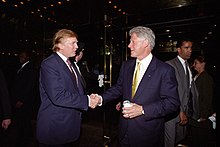
Trump registered as a Republican in 1987;[143] a member of the Independence Party, the New York state affiliate of the Reform Party, in 1999;[144] a Democrat in 2001; a Republican in 2009; unaffiliated in 2011; and a Republican in 2012.[143]
In 1987, Trump placed full-page advertisements in three major newspapers,[145] expressing his views on foreign policy and how to eliminate the federal budget deficit.[146] In 1988, he approached Lee Atwater, asking to be put into consideration to be Republican nominee George H. W. Bush's running mate. Bush found the request "strange and unbelievable".[147]
Presidential campaigns (2000–2016)
Trump was a candidate in the 2000 Reform Party presidential primaries for three months but withdrew from the race in February 2000.[148][149][150]
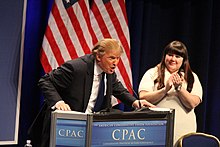
In 2011, Trump speculated about running against President Barack Obama in the 2012 election, making his first speaking appearance at the Conservative Political Action Conference (CPAC) in February 2011 and giving speeches in early primary states.[151][152] In May 2011, he announced he would not run.[151] Trump's presidential ambitions were generally not taken seriously at the time.[153]
2016 presidential campaign
Trump's fame and provocative statements earned him an unprecedented amount of free media coverage, elevating his standing in the Republican primaries.[154] He adopted the phrase "truthful hyperbole", coined by his ghostwriter Tony Schwartz, to describe his public speaking style.[131][155] His campaign statements were often opaque and suggestive,[156] and a record number were false.[157][158][159] Trump said he disdained political correctness and frequently made claims of media bias.[160][161] His run for office led to the creation of a political movement and cult of personality.[b]

Trump announced his candidacy in June 2015.[173][174] His campaign was initially not taken seriously by political analysts, but he quickly rose to the top of opinion polls.[175] He became the front-runner in March 2016[176] and was declared the presumptive Republican nominee in May.[177]
Hillary Clinton led Trump in national polling averages throughout the campaign, but, in early July, her lead narrowed.[178][179] In mid-July Trump selected Indiana governor Mike Pence as his running mate,[180] and the two were officially nominated at the 2016 Republican National Convention.[181] Trump and Clinton faced off in three presidential debates in September and October 2016. Trump twice refused to say whether he would accept the result of the election.[182]
Campaign rhetoric and political positions
Trump's political positions and rhetoric were described as right-wing populist.[183][184][185] Politico described them as "eclectic, improvisational and often contradictory", quoting a health-care policy expert at the American Enterprise Institute as saying that his political positions were a "random assortment of whatever plays publicly".[186] NBC News counted "141 distinct shifts on 23 major issues" during his campaign.[187] Trump appeals to Christian nationalists, according to a 2021 study.[188]
Trump described NATO as "obsolete"[189][190] and espoused views that were described as non-interventionist and protectionist.[191] His campaign platform emphasized renegotiating U.S.–China relations and free trade agreements such as NAFTA, strongly enforcing immigration laws, and building a new wall along the U.S.–Mexico border. Other campaign positions included pursuing energy independence while opposing climate change regulations, modernizing services for veterans, repealing and replacing the Affordable Care Act, abolishing Common Core education standards, investing in infrastructure, simplifying the tax code while reducing taxes, and imposing tariffs on imports by companies that offshore jobs. He advocated increasing military spending and extreme vetting or banning of immigrants from Muslim-majority countries.[192]
Trump helped bring far-right fringe ideas and organizations into the mainstream.[193] In August 2016, Trump hired Steve Bannon, the executive chairman of Breitbart News—described by Bannon as "the platform for the alt-right"—as his campaign CEO.[194] The alt-right movement coalesced around and supported Trump's candidacy, due in part to its opposition to multiculturalism and immigration.[195][196][197]
Financial disclosures
Trump's FEC-required reports listed assets above $1.4 billion and outstanding debts of at least $315 million.[37][198] Trump did not release his tax returns, contrary to the practice of every major candidate since 1976 and his promises in 2014 and 2015 to do so if he ran for office.[199][200] He said his tax returns were being audited, and that his lawyers had advised him against releasing them.[201] After a lengthy court battle to block release of his tax returns and other records to the Manhattan district attorney for a criminal investigation, including two appeals by Trump to the U.S. Supreme Court, in February 2021 the high court allowed the records to be released to the prosecutor for review by a grand jury.[202][203]
In October 2016, portions of Trump's state filings for 1995 were leaked to a reporter from The New York Times. They show that Trump had declared a loss of $916 million that year, which could have let him avoid taxes for up to 18 years.[204]
Election to the presidency
On November 8, 2016, Trump received 306 pledged electoral votes versus 232 for Clinton, though, after elector defections on both sides, the official count was ultimately 304 to 227.[205] Trump, the fifth person to be elected president while losing the popular vote, received nearly 2.9 million fewer votes than Clinton.[206] He also was the only president who neither served in the military nor held any government office prior to becoming president.[207] Trump's victory was a political upset.[208] Polls had consistently shown Clinton with a nationwide—though diminishing—lead, as well as an advantage in most of the competitive states.[209]

Trump won 30 states, including Michigan, Pennsylvania, and Wisconsin, states which had been considered a blue wall of Democratic strongholds since the 1990s. Clinton won 20 states and the District of Columbia. Trump's victory marked the return of an undivided Republican government—a Republican White House combined with Republican control of both chambers of Congress.[210]
Trump's election victory sparked protests in major U.S. cities.[211][212] On the day after Trump's inauguration, an estimated 2.6 million people worldwide, including an estimated half million in Washington, D.C., protested against Trump in the Women's Marches.[213]
First presidency (2017–2021)
| This article is part of a series on |
| Conservatism in the United States |
|---|
 |
Early actions

Trump was inaugurated on January 20, 2017. During his first week in office, he signed six executive orders, authorizing interim procedures in anticipation of repealing the Affordable Care Act ("Obamacare"), withdrawal from the Trans-Pacific Partnership negotiations, reinstatement of the Mexico City policy, advancement of the Keystone XL and Dakota Access Pipeline construction projects, reinforcement of border security, and a planning and design process to construct a wall along the U.S. border with Mexico.[214]
Trump's daughter Ivanka and son-in-law Jared Kushner became his assistant and senior advisor, respectively.[215][216]
Conflicts of interest
Before being inaugurated, Trump moved his businesses into a revocable trust,[217][218] rather than a blind trust or equivalent arrangement "to cleanly sever himself from his business interests".[219] Trump continued to profit from his businesses and to know how his administration's policies affected his businesses.[218][220] Though he said he would eschew "new foreign deals", the Trump Organization pursued expansions of its operations in Dubai, Scotland, and the Dominican Republic.[218][220]
Trump was sued for violating the Domestic and Foreign Emoluments Clauses of the U.S. Constitution, marking the first time that the clauses had been substantively litigated.[221] One case was dismissed in lower court.[222] Two were dismissed by the U.S. Supreme Court as moot after the end of Trump's term.[223] During Trump's term in office, he visited a Trump Organization property on 428 days, one visit for every 3.4 days of his presidency.[224]
Domestic policy
Economy
Trump took office at the height of the longest economic expansion in American history,[225] which began in 2009 and continued until February 2020, when the COVID-19 recession began.[226]
In December 2017, Trump signed the Tax Cuts and Jobs Act of 2017 passed by Congress without Democratic votes.[relevant?] It reduced tax rates for businesses and individuals, with business tax cuts to be permanent and individual tax cuts set to expire after 2025,[importance?] and set the penalty associated with the Affordable Care Act's individual mandate to $0.[227][228] The Trump administration claimed that the act would not decrease government revenue, but 2018 revenues were 7.6 percent lower than projected.[229]
Under Trump, the federal budget deficit increased by almost 50 percent, to nearly $1 trillion in 2019.[230] By the end of his term, the U.S. national debt increased by 39 percent, reaching $27.75 trillion, and the U.S. debt-to-GDP ratio hit a post-World War II high.[231] Trump also failed to deliver the $1 trillion infrastructure spending plan on which he had campaigned.[232]
Trump is the only modern U.S. president to leave office with a smaller workforce than when he took office, by 3 million people.[225][233]
Climate change, environment, and energy
Trump rejects the scientific consensus on climate change.[234][235][236][237] He reduced the budget for renewable energy research by 40 percent and reversed Obama-era policies directed at curbing climate change.[238] He withdrew from the Paris Agreement, making the U.S. the only nation to not ratify it.[239]
Trump aimed to boost the production and exports of fossil fuels.[240][241] Natural gas expanded under Trump, but coal continued to decline.[242][243] Trump rolled back more than 100 federal environmental regulations, including those that curbed greenhouse gas emissions, air and water pollution, and the use of toxic substances. He weakened protections for animals and environmental standards for federal infrastructure projects, and expanded permitted areas for drilling and resource extraction, such as allowing drilling in the Arctic Refuge.[244]
Deregulation
In 2017, Trump signed Executive Order 13771, which directed that, for every new regulation, federal agencies "identify" two existing regulations for elimination, though it did not require elimination.[245] He dismantled many federal regulations on health,[246][247] labor,[248][247] and the environment,[249][247] among others, including a bill that made it easier for severely mentally ill persons to buy guns.[250] During his first six weeks in office, he delayed, suspended, or reversed ninety federal regulations,[251] often "after requests by the regulated industries".[252] The Institute for Policy Integrity found that 78 percent of Trump's proposals were blocked by courts or did not prevail over litigation.[253]
Health care
During his campaign, Trump vowed to repeal and replace the Affordable Care Act.[254] In office, he scaled back the Act's implementation through executive orders.[255][256] Trump expressed a desire to "let Obamacare fail"; his administration halved the enrollment period and drastically reduced funding for enrollment promotion.[257][258] In June 2018, the Trump administration joined 18 Republican-led states in arguing before the Supreme Court that the elimination of the financial penalties associated with the individual mandate had rendered the Act unconstitutional.[259][260] Their pleading would have eliminated health insurance coverage for up to 23 million Americans, but was unsuccessful.[259] During the 2016 campaign, Trump promised to protect funding for Medicare and other social safety-net programs. In January 2020, he expressed willingness to consider cuts to them.[261]
In response to the opioid epidemic, Trump signed legislation in 2018 to increase funding for drug treatments but was widely criticized for failing to make a concrete strategy. U.S. opioid overdose deaths declined slightly in 2018 but surged to a record 50,052 in 2019.[262]
Social issues
Trump barred organizations that provide abortions or abortion referrals from receiving federal funds.[263] He said he supported "traditional marriage" but considered the nationwide legality of same-sex marriage "settled".[264] His administration rolled back key components of the Obama administration's workplace protections against discrimination of LGBTQ people.[265] Trump's attempted rollback of anti-discrimination protections for transgender patients in August 2020 was halted by a federal judge after a Supreme Court ruling extended employees' civil rights protections to gender identity and sexual orientation.[266]
Trump has said he is opposed to gun control, although his views have shifted over time.[267] After several mass shootings during his term, he said he would propose legislation related to guns, but he abandoned that effort in November 2019.[268] His administration took an anti-marijuana position, revoking Obama-era policies that provided protections for states that legalized marijuana.[269]
Trump is a long-time advocate of capital punishment.[270][271] Under his administration, the federal government executed 13 prisoners, more than in the previous 56 years combined, ending a 17-year moratorium.[272] In 2016, Trump said he supported the use of interrogation torture methods such as waterboarding.[273][274]
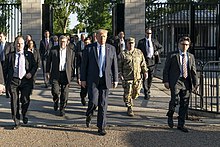
In June 2020, during the George Floyd protests, federal law-enforcement officials controversially used less lethal weapons to remove a largely peaceful crowd of lawful protesters from Lafayette Square, outside the White House.[275][276] Trump then posed with a Bible for a photo-op at the nearby St. John's Episcopal Church,[275][277][278] with religious leaders condemning both the treatment of protesters and the photo opportunity itself.[279] Many retired military leaders and defense officials condemned Trump's proposal to use the U.S. military against anti-police-brutality protesters.[280]
Pardons and commutations
Trump granted 237 requests for clemency, fewer than all presidents since 1900 with the exception of George H. W. Bush and George W. Bush.[281] Only 25 of them had been vetted by the Justice Department's Office of the Pardon Attorney; the others were granted to people with personal or political connections to him, his family, and his allies, or recommended by celebrities.[282][283] In his last full day in office, Trump granted 73 pardons and commuted 70 sentences.[284] Several Trump allies were not eligible for pardons under Justice Department rules, and in other cases the department had opposed clemency.[282] The pardons of three military service members convicted of or charged with violent crimes were opposed by military leaders.[285]
Immigration
Trump's proposed immigration policies were a topic of bitter debate during the 2016 campaign. He promised to build a wall on the Mexico–U.S. border to restrict illegal movement and vowed that Mexico would pay for it.[286] He pledged to deport millions of illegal immigrants residing in the U.S.,[287] and criticized birthright citizenship for incentivizing "anchor babies".[288] As president, he frequently described illegal immigration as an "invasion" and conflated immigrants with the criminal gang MS-13.[289]
Trump drastically escalated immigration enforcement, including implementing harsher immigration enforcement policies against asylum seekers from Central America than any modern U.S. president.[290][291]
From 2018 onward, Trump deployed nearly 6,000 troops to the U.S.–Mexico border[292] to stop most Central American migrants from seeking asylum. In 2020, his administration widened the public charge rule to further restrict immigrants who might use government benefits from getting permanent residency.[293] Trump reduced the number of refugees admitted to record lows. When Trump took office, the annual limit was 110,000; Trump set a limit of 18,000 in the 2020 fiscal year and 15,000 in the 2021 fiscal year.[294][295] Additional restrictions implemented by the Trump administration caused significant bottlenecks in processing refugee applications, resulting in fewer refugees accepted than the allowed limits.[296]
Travel ban
Following the 2015 San Bernardino attack, Trump proposed to ban Muslim foreigners from entering the U.S. until stronger vetting systems could be implemented.[297] He later reframed the proposed ban to apply to countries with a "proven history of terrorism".[298]
On January 27, 2017, Trump signed Executive Order 13769, which suspended admission of refugees for 120 days and denied entry to citizens of Iraq, Iran, Libya, Somalia, Sudan, Syria, and Yemen for 90 days, citing security concerns. The order took effect immediately and without warning, causing chaos at airports.[299][300] Protests began at airports the next day,[299][300] and legal challenges resulted in nationwide preliminary injunctions.[301] A March 6 revised order, which excluded Iraq and gave other exemptions, again was blocked by federal judges in three states.[302][303] In a decision in June 2017, the Supreme Court ruled that the ban could be enforced on visitors who lack a "credible claim of a bona fide relationship with a person or entity in the United States".[304]
The temporary order was replaced by Presidential Proclamation 9645 on September 24, 2017, which restricted travel from the originally targeted countries except Iraq and Sudan, and further banned travelers from North Korea and Chad, along with certain Venezuelan officials.[305] After lower courts partially blocked the new restrictions, the Supreme Court allowed the September version to go into full effect on December 4, 2017,[306] and ultimately upheld the travel ban in a ruling in June 2019.[307]
Family separation at the border
The Trump administration separated more than 5,400 children of migrant families from their parents at the U.S.–Mexico border, a sharp increase in the number of family separations at the border starting from the summer of 2017.[308][309] In April 2018, the Trump administration announced a "zero tolerance" policy whereby adults suspected of illegal entry were to be detained and criminally prosecuted while their children were taken away as unaccompanied alien minors.[310][311] The policy was unprecedented in previous administrations and sparked public outrage.[312][313] Trump falsely asserted that his administration was merely following the law, blaming Democrats, despite the separations being his administration's policy.[314][315][316]
Although Trump originally argued that the separations could not be stopped by an executive order, he acceded to intense public objection and signed an executive order in June 2018, mandating that migrant families be detained together unless "there is a concern" of a risk to the child.[317][318] On June 26, 2018, Judge Dana Sabraw concluded that the Trump administration had "no system in place to keep track of" the separated children, nor any effective measures for family communication and reunification;[319] Sabraw ordered for the families to be reunited and family separations stopped except in limited circumstances.[320] After the order, the Trump administration separated more than a thousand migrant children from their families; the ACLU contended that the Trump administration had abused its discretion and asked Sabraw to more narrowly define the circumstances warranting separation.[309]
Trump wall and government shutdown
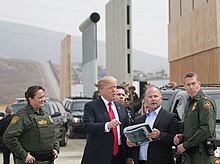
One of Trump's central campaign promises was to build a 1,000-mile (1,600 km) border wall to Mexico and have Mexico pay for it.[321] By the end of his term, the U.S. had built "40 miles [64 km] of new primary wall and 33 miles [53 km] of secondary wall" in locations where there had been no barriers and 365 miles (587 km) of primary or secondary border fencing replacing dilapidated or outdated barriers.[322]
In 2018, Trump refused to sign any appropriations bill from Congress unless it allocated $5.6 billion for the border wall,[323] resulting in the federal government partially shutting down for 35 days from December 2018 to January 2019, the longest U.S. government shutdown in history.[324][325] Around 800,000 government employees were furloughed or worked without pay.[326] Trump and Congress ended the shutdown by approving temporary funding that provided delayed payments to government workers but no funds for the wall.[324] The shutdown resulted in an estimated permanent loss of $3 billion to the economy, according to the Congressional Budget Office.[327] About half of those polled blamed Trump for the shutdown, and Trump's approval ratings dropped.[328]
To prevent another imminent shutdown in February 2019, Congress passed and Trump signed a funding bill that included $1.375 billion for 55 miles (89 km) of bollard border fencing.[329] Trump also declared a national emergency on the southern border, intending to divert $6.1 billion of funds Congress had allocated to other purposes.[329] Trump vetoed a joint resolution to overturn the declaration, and the Senate voted against a veto override.[330] Legal challenges to the diversion of $2.5 billion originally meant for the Department of Defense's drug interdiction efforts[331][332] and $3.6 billion originally meant for military construction[333][334] were unsuccessful.
Foreign policy

Trump described himself as a "nationalist"[335] and his foreign policy as "America First".[336] He praised and supported populist, neo-nationalist, and authoritarian governments.[337] Hallmarks of foreign relations during Trump's tenure included unpredictability, uncertainty, and inconsistency.[336][338] Tensions between the U.S. and its European allies were strained under Trump.[339] He criticized NATO allies and privately suggested on multiple occasions that the U.S. should withdraw from NATO.[340][341]
Trade
Trump withdrew the U.S. from the Trans-Pacific Partnership (TPP) negotiations,[342] imposed tariffs on steel and aluminum imports,[343] and launched a trade war with China by sharply increasing tariffs on 818 categories (worth $50 billion) of Chinese goods imported into the U.S.[344] While Trump said that import tariffs are paid by China into the U.S. Treasury, they are paid by American companies that import goods from China.[345] Although he pledged during the campaign to significantly reduce the U.S.'s large trade deficits, the trade deficit skyrocketed under Trump.[346] Following a 2017–2018 renegotiation, the United States–Mexico–Canada Agreement (USMCA) became effective in July 2020 as the successor to NAFTA.[347]
Russia
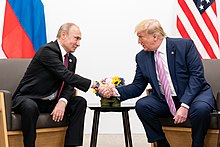
The Trump administration weakened the toughest sanctions imposed by the U.S. against Russian entities after Russia's 2014 annexation of Crimea.[348][349] Trump withdrew the U.S. from the Intermediate-Range Nuclear Forces Treaty, citing alleged Russian non-compliance,[350] and supported a potential return of Russia to the G7.[351]
Trump repeatedly praised and rarely criticized Russian president Vladimir Putin[352][353] but opposed some actions of the Russian government.[354][355] After he met Putin at the Helsinki Summit in 2018, Trump drew bipartisan criticism for accepting Putin's denial of Russian interference in the 2016 presidential election, rather than accepting the findings of U.S. intelligence agencies.[356][357][358] Trump did not discuss alleged Russian bounties offered to Taliban fighters for attacking American soldiers in Afghanistan with Putin, saying both that he doubted the intelligence and that he was not briefed on it.[359]
China
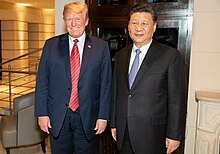
Trump repeatedly accused China of taking unfair advantage of the U.S.[360] He launched a trade war against China that was widely characterized as a failure,[361][362][363] sanctioned Huawei for alleged ties to Iran,[364] significantly increased visa restrictions on Chinese students and scholars,[365] and classified China as a currency manipulator.[366] Trump also juxtaposed verbal attacks on China with praise of Chinese Communist Party leader Xi Jinping,[367] which was attributed to trade war negotiations.[368] After initially praising China for its handling of COVID-19,[369] he began a campaign of criticism starting in March 2020.[370]
Trump said he resisted punishing China for its human rights abuses against ethnic minorities in the Xinjiang region for fear of jeopardizing trade negotiations.[371] In July 2020, the Trump administration imposed sanctions and visa restrictions against senior Chinese officials, in response to expanded mass detention camps holding more than a million of the country's Uyghur minority.[372]
North Korea

In 2017, when North Korea's nuclear weapons were increasingly seen as a serious threat,[373] Trump escalated his rhetoric, warning that North Korean aggression would be met with "fire and fury like the world has never seen".[374][375] In 2017, Trump declared that he wanted North Korea's "complete denuclearization", and engaged in name-calling with leader Kim Jong Un.[374][376] After this period of tension, Trump and Kim exchanged at least 27 letters in which the two men described a warm personal friendship.[377][378] In March 2019, Trump lifted some U.S. sanctions against North Korea against the advice of his Treasury Department.[379]
Trump, the first sitting U.S. president to meet a North Korean leader, met Kim three times: in Singapore in 2018, in Hanoi in 2019, and in the Korean Demilitarized Zone in 2019.[380] However, no denuclearization agreement was reached,[381] and talks in October 2019 broke down after one day.[382] While conducting no nuclear tests since 2017, North Korea continued to build up its arsenal of nuclear bombs and ballistic missiles.[383][384]
Afghanistan
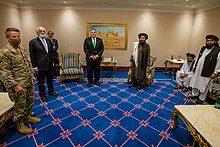
U.S. troop numbers in Afghanistan increased from 8,500 in January 2017 to 14,000 a year later,[385] reversing Trump's pre-election position critical of further involvement in Afghanistan.[386] In February 2020, the Trump administration signed a peace agreement with the Taliban, which called for the withdrawal of foreign troops in 14 months "contingent on a guarantee from the Taliban that Afghan soil will not be used by terrorists with aims to attack the United States or its allies" and for the U.S. to seek the release of 5,000 Taliban imprisoned by the Afghan government.[387][388][389] By the end of Trump's term, 5,000 Taliban had been released, and, despite the Taliban continuing attacks on Afghan forces and integrating Al-Qaeda members into its leadership, U.S. troops had been reduced to 2,500.[389]
Israel
Trump supported many of the policies of Israeli Prime Minister Benjamin Netanyahu.[390] Under Trump, the U.S. recognized Jerusalem as the capital of Israel[391] and Israeli sovereignty over the Golan Heights,[392] leading to international condemnation including from the UN General Assembly, European Union, and Arab League.[393][394] In 2020, the White House hosted the signing of agreements, named Abraham Accords, between Israel and the United Arab Emirates and Bahrain to normalize their foreign relations.[395]
Saudi Arabia

Trump actively supported the Saudi Arabian–led intervention in Yemen against the Houthis and in 2017 signed a $110 billion agreement to sell arms to Saudi Arabia.[396] In 2018, the U.S. provided limited intelligence and logistical support for the intervention.[397][398] Following the 2019 attack on Saudi oil facilities, which the U.S. and Saudi Arabia blamed on Iran, Trump approved the deployment of 3,000 additional U.S. troops, including fighter squadrons, two Patriot batteries, and a Terminal High Altitude Area Defense system, to Saudi Arabia and the United Arab Emirates.[399]
Syria
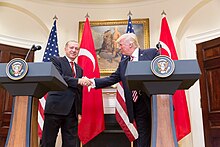
Trump ordered missile strikes in April 2017 and April 2018 against the Assad regime in Syria, in retaliation for the Khan Shaykhun and Douma chemical attacks, respectively.[400][401] In December 2018, Trump declared "we have won against ISIS", contradicting Department of Defense assessments, and ordered the withdrawal of all troops from Syria.[402][403] The next day, Mattis resigned in protest, calling Trump's decision an abandonment of the U.S.'s Kurdish allies who played a key role in fighting ISIS.[404] In October 2019, after Trump spoke to Turkish president Recep Tayyip Erdoğan, U.S. troops in northern Syria were withdrawn from the area and Turkey invaded northern Syria, attacking and displacing American-allied Kurds.[405] Later that month, the U.S. House of Representatives, in a rare bipartisan vote of 354–60, condemned Trump's withdrawal of U.S. troops from Syria, for "abandoning U.S. allies, undermining the struggle against ISIS, and spurring a humanitarian catastrophe".[406][407]
Iran
In May 2018, Trump withdrew the U.S. from the Joint Comprehensive Plan of Action, the 2015 agreement that lifted most economic sanctions against Iran in return for restrictions on Iran's nuclear program.[408][409] In August 2020, the Trump administration unsuccessfully attempted to use a section of the nuclear deal to have the UN reimpose sanctions against Iran.[410] Analysts determined that, after the U.S. withdrawal, Iran moved closer to developing a nuclear weapon.[411][412]
On January 1, 2020, Trump ordered a U.S. airstrike that killed Iranian general Qasem Soleimani, who had planned nearly every significant Iranian and Iranian-backed operation over the preceding two decades.[413][414] One week later, Iran retaliated with ballistic missile strikes against two U.S. airbases in Iraq. Dozens of soldiers sustained traumatic brain injuries. Trump downplayed their injuries, and they were initially denied Purple Heart medals and the benefits accorded to their recipients.[415][411]
Personnel
The Trump administration had a high turnover of personnel, particularly among White House staff. By the end of Trump's first year in office, 34 percent of his original staff had resigned, been fired, or been reassigned.[416] As of early July 2018[update], 61 percent of Trump's senior aides had left[417] and 141 staffers had left in the previous year.[418] Both figures set a record for recent presidents—more change in the first 13 months than his four immediate predecessors saw in their first two years.[419] Notable early departures included National Security Advisor Michael Flynn (after just 25 days), and Press Secretary Sean Spicer.[419] Close personal aides to Trump including Bannon, Hope Hicks, John McEntee, and Keith Schiller quit or were forced out.[420] Some later returned in different posts.[421] Trump publicly disparaged several of his former top officials, calling them incompetent, stupid, or crazy.[422]
Trump had four White House chiefs of staff, marginalizing or pushing out several.[423] Reince Priebus was replaced after seven months by retired Marine general John F. Kelly.[424] Kelly resigned in December 2018 after a tumultuous tenure in which his influence waned, and Trump subsequently disparaged him.[425] Kelly was succeeded by Mick Mulvaney as acting chief of staff; he was replaced in March 2020 by Mark Meadows.[423]
On May 9, 2017, Trump dismissed FBI director James Comey. While initially attributing this action to Comey's conduct in the investigation about Hillary Clinton's emails, Trump said a few days later that he was concerned with Comey's role in the ongoing Trump-Russia investigations, and that he had intended to fire Comey earlier.[426] At a private conversation in February, Trump said he hoped Comey would drop the investigation into Flynn.[427] In March and April, Trump asked Comey to "lift the cloud impairing his ability to act" by saying publicly that the FBI was not investigating him.[427][428]
Trump lost three of his 15 original cabinet members within his first year.[429] Health and Human Services secretary Tom Price was forced to resign in September 2017 due to excessive use of private charter jets and military aircraft.[429][420] Environmental Protection Agency administrator Scott Pruitt resigned in 2018 and Secretary of the Interior Ryan Zinke in January 2019 amid multiple investigations into their conduct.[430][431]
Trump was slow to appoint second-tier officials in the executive branch, saying many of the positions are unnecessary. In October 2017, there were still hundreds of sub-cabinet positions without a nominee.[432] By January 8, 2019, of 706 key positions, 433 had been filled (61 percent) and Trump had no nominee for 264 (37 percent).[433]
Judiciary
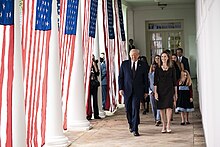
Trump appointed 226 Article III judges, including 54 to the courts of appeals and three to the Supreme Court: Neil Gorsuch, Brett Kavanaugh, and Amy Coney Barrett.[434] His Supreme Court nominees were noted as having politically shifted the Court to the right.[435][436][437] In the 2016 campaign, he pledged that Roe v. Wade would be overturned "automatically" if he were elected and provided the opportunity to appoint two or three anti-abortion justices. He later took credit when Roe was overturned in Dobbs v. Jackson Women's Health Organization; all three of his Supreme Court nominees voted with the majority.[438][439][440]
Trump disparaged courts and judges he disagreed with, often in personal terms, and questioned the judiciary's constitutional authority. His attacks on the courts drew rebukes from observers, including sitting federal judges, concerned about the effect of his statements on the judicial independence and public confidence in the judiciary.[441][442][443]
COVID-19 pandemic
Initial response
The first confirmed case of COVID-19 in the U.S. was reported on January 20, 2020.[444] The outbreak was officially declared a public health emergency by Health and Human Services (HHS) Secretary Alex Azar on January 31, 2020.[445] Trump initially ignored persistent public health warnings and calls for action from health officials within his administration and Secretary Azar.[446][447] Throughout January and February he focused on economic and political considerations of the outbreak.[448] In February 2020 Trump publicly asserted that the outbreak in the U.S. was less deadly than influenza, was "very much under control", and would soon be over.[449] On March 19, 2020, Trump privately told Bob Woodward that he was deliberately "playing it down, because I don't want to create a panic".[450][451]
By mid-March, most global financial markets had severely contracted in response to the pandemic.[452] On March 6, Trump signed the Coronavirus Preparedness and Response Supplemental Appropriations Act, which provided $8.3 billion in emergency funding for federal agencies.[453] On March 11, the World Health Organization (WHO) recognized COVID-19 as a pandemic,[454] and Trump announced partial travel restrictions for most of Europe, effective March 13.[455] That same day, he gave his first serious assessment of the virus in a nationwide Oval Office address, calling the outbreak "horrible" but "a temporary moment" and saying there was no financial crisis.[456] On March 13, he declared a national emergency, freeing up federal resources.[457] Trump claimed that "anybody that wants a test can get a test", despite test availability being severely limited.[458]
On April 22, Trump signed an executive order restricting some forms of immigration.[459] In late spring and early summer, with infections and deaths continuing to rise, he adopted a strategy of blaming the states rather than accepting that his initial assessments of the pandemic were overly optimistic or his failure to provide presidential leadership.[460]
White House Coronavirus Task Force
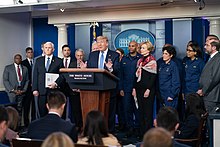
Trump established the White House Coronavirus Task Force on January 29, 2020.[461] Beginning in mid-March, Trump held a daily task force press conference, joined by medical experts and other administration officials,[462] sometimes disagreeing with them by promoting unproven treatments.[463] Trump was the main speaker at the briefings, where he praised his own response to the pandemic, frequently criticized rival presidential candidate Joe Biden, and denounced the press.[462][464] On March 16, he acknowledged for the first time that the pandemic was not under control and that months of disruption to daily lives and a recession might occur.[465] His repeated use of "Chinese virus" and "China virus" to describe COVID-19 drew criticism from health experts.[466][467][468]
By early April, as the pandemic worsened and amid criticism of his administration's response, Trump refused to admit any mistakes in his handling of the outbreak, instead blaming the media, Democratic state governors, the previous administration, China, and the WHO.[469] The daily coronavirus task force briefings ended in late April, after a briefing at which Trump suggested the dangerous idea of injecting a disinfectant to treat COVID-19;[470] the comment was widely condemned by medical professionals.[471][472]
In early May, Trump proposed the phase-out of the coronavirus task force and its replacement with another group centered on reopening the economy. Amid a backlash, Trump said the task force would "indefinitely" continue.[473] By the end of May, the coronavirus task force's meetings were sharply reduced.[474]
World Health Organization
Prior to the pandemic, Trump criticized the WHO and other international bodies, which he asserted were taking advantage of U.S. aid.[475] His administration's proposed 2021 federal budget, released in February, proposed reducing WHO funding by more than half.[475] In May and April, Trump accused the WHO of "severely mismanaging" COVID-19, alleged without evidence that the organization was under Chinese control and had enabled the Chinese government's concealment of the pandemic's origins,[475][476][477] and announced that he was withdrawing funding for the organization.[475] These were seen as attempts to distract from his own mishandling of the pandemic.[475][478][479] In July 2020, Trump announced the formal withdrawal of the U.S. from the WHO, effective July 2021.[476][477] The decision was widely condemned by health and government officials as "short-sighted", "senseless", and "dangerous".[476][477]
Pressure to abandon pandemic mitigation measures
In April 2020, Republican-connected groups organized anti-lockdown protests against the measures state governments were taking to combat the pandemic;[480][481] Trump encouraged the protests on Twitter,[482] even though the targeted states did not meet the Trump administration's guidelines for reopening.[483] In April 2020, he first supported, then later criticized, Georgia Governor Brian Kemp's plan to reopen some nonessential businesses.[484] Throughout the spring he increasingly pushed for ending the restrictions to reverse the damage to the country's economy.[485] Trump often refused to mask at public events, contrary to his administration's April 2020 guidance to wear masks in public[486] and despite nearly unanimous medical consensus that masks are important to preventing spread of the virus.[487] By June, Trump had said masks were a "double-edged sword"; ridiculed Biden for wearing masks; continually emphasized that mask-wearing was optional; and suggested that wearing a mask was a political statement against him personally.[487] Trump's contradiction of medical recommendations weakened national efforts to mitigate the pandemic.[486][487]
In June and July, Trump said several times that the U.S. would have fewer cases of coronavirus if it did less testing, that having a large number of reported cases "makes us look bad".[488][489] The CDC guideline at the time was that any person exposed to the virus should be "quickly identified and tested" even if they are not showing symptoms, because asymptomatic people can still spread the virus.[490][491] In August 2020 the CDC quietly lowered its recommendation for testing, advising that people who have been exposed to the virus, but are not showing symptoms, "do not necessarily need a test". The change in guidelines was made by HHS political appointees under Trump administration pressure, against the wishes of CDC scientists.[492][493] The day after this political interference was reported, the testing guideline was changed back to its original recommendation.[493]
Despite record numbers of COVID-19 cases in the U.S. from mid-June onward and an increasing percentage of positive test results, Trump largely continued to downplay the pandemic, including his false claim in early July 2020 that 99 percent of COVID-19 cases are "totally harmless".[494][495] He began insisting that all states should resume in-person education in the fall despite a July spike in reported cases.[496]
Political pressure on health agencies
Trump repeatedly pressured federal health agencies to take actions he favored,[492] such as approving unproven treatments[497][498] or speeding up vaccine approvals.[498] Trump administration political appointees at HHS sought to control CDC communications to the public that undermined Trump's claims that the pandemic was under control. CDC resisted many of the changes, but increasingly allowed HHS personnel to review articles and suggest changes before publication.[499][500] Trump alleged without evidence that FDA scientists were part of a "deep state" opposing him and delaying approval of vaccines and treatments to hurt him politically.[501]
Outbreak at the White House

On October 2, 2020, Trump tweeted that he had tested positive for COVID-19, part of a White House outbreak.[502] Later that day Trump was hospitalized at Walter Reed National Military Medical Center, reportedly due to fever and labored breathing. He was treated with antiviral and experimental antibody drugs and a steroid. He returned to the White House on October 5, still infectious and unwell.[503][504] During and after his treatment he continued to downplay the virus.[503] In 2021, it was revealed that his condition had been far more serious; he had dangerously low blood oxygen levels, a high fever, and lung infiltrates, indicating a severe case.[504]
Effects on the 2020 presidential campaign
By July 2020, Trump's handling of the COVID-19 pandemic had become a major issue in the presidential election.[505] Biden sought to make the pandemic the central issue.[506] Polls suggested voters blamed Trump for his pandemic response[505] and disbelieved his rhetoric concerning the virus, with an Ipsos/ABC News poll indicating 65 percent of respondents disapproved of his pandemic response.[507] In the final months of the campaign, Trump repeatedly said that the U.S. was "rounding the turn" in managing the pandemic, despite increasing cases and deaths.[508] A few days before the November 3 election, the U.S. reported more than 100,000 cases in a single day for the first time.[509]
Investigations
After he assumed office, Trump was the subject of increasing Justice Department and congressional scrutiny, with investigations covering his election campaign, transition, and inauguration, actions taken during his presidency, his private businesses, personal taxes, and charitable foundation.[510] There were ten federal criminal investigations, eight state and local investigations, and twelve congressional investigations.[511]
In April 2019, the House Oversight Committee issued subpoenas seeking financial details from Trump's banks, Deutsche Bank and Capital One, and his accounting firm, Mazars USA. Trump sued the banks, Mazars, and committee chair Elijah Cummings to prevent the disclosures.[512] In May, DC District Court judge Amit Mehta ruled that Mazars must comply with the subpoena,[513] and judge Edgardo Ramos of the Southern District Court of New York ruled that the banks must also comply.[514][515] Trump's attorneys appealed.[516] In September 2022, the committee and Trump agreed to a settlement about Mazars, and the accounting firm began turning over documents.[517]
Russian election interference
In January 2017, American intelligence agencies—the CIA, the FBI, and the NSA, represented by the Director of National Intelligence—jointly stated with "high confidence" that the Russian government interfered in the 2016 presidential election to favor the election of Trump.[518][519] In March 2017, FBI Director James Comey told Congress, "[T]he FBI, as part of our counterintelligence mission, is investigating the Russian government's efforts to interfere in the 2016 presidential election. That includes investigating the nature of any links between individuals associated with the Trump campaign and the Russian government, and whether there was any coordination between the campaign and Russia's efforts."[520]
Many suspicious[521] links between Trump associates and Russian officials and spies were discovered and the relationships between Russians and "team Trump", including Manafort, Flynn, and Stone, were widely reported by the press.[522][523][524][525] Members of Trump's campaign and his White House staff, particularly Flynn, were in contact with Russian officials both before and after the election.[526][527] On December 29, 2016, Flynn talked with Russian Ambassador Sergey Kislyak about sanctions that were imposed that same day; Flynn later resigned in the midst of controversy over whether he misled Pence.[528] Trump told Kislyak and Sergei Lavrov in May 2017 he was unconcerned about Russian interference in U.S. elections.[529]
Trump and his allies promoted a conspiracy theory that Ukraine, rather than Russia, interfered in the 2016 election—which was also promoted by Russia to frame Ukraine.[530]
FBI Crossfire Hurricane and 2017 counterintelligence investigations
In July 2016, the FBI launched an investigation, codenamed Crossfire Hurricane, into possible links between Russia and the Trump campaign.[531] After Trump fired FBI director James Comey in May 2017, the FBI opened a counterintelligence investigation into Trump's personal and business dealings with Russia.[532] Crossfire Hurricane was transferred to the Mueller investigation,[533] but Deputy Attorney General Rod Rosenstein ended the investigation into Trump's direct ties to Russia while giving the bureau the false impression that the Robert Mueller's special counsel investigation would pursue the matter.[534][535]
Mueller investigation
In May 2017, Rosenstein appointed former FBI director Mueller special counsel for the Department of Justice (DOJ), ordering him to "examine 'any links and/or coordination between the Russian government' and the Trump campaign". He privately told Mueller to restrict the investigation to criminal matters "in connection with Russia's 2016 election interference".[534] The special counsel also investigated whether Trump's dismissal of James Comey as FBI director constituted obstruction of justice[536] and the Trump campaign's possible ties to Saudi Arabia, the United Arab Emirates, Turkey, Qatar, Israel, and China.[537] Trump sought to fire Mueller and shut down the investigation multiple times but backed down after his staff objected or after changing his mind.[538]
In March 2019, Mueller gave his final report to Attorney General William Barr,[539] which Barr purported to summarize in a letter to Congress. A federal court, and Mueller himself, said Barr mischaracterized the investigation's conclusions and, in so doing, confused the public.[540][541][542] Trump repeatedly claimed that the investigation exonerated him; the Mueller report expressly stated that it did not.[543]
A redacted version of the report, publicly released in April 2019, found that Russia interfered in 2016 to favor Trump.[544] Despite "numerous links between the Russian government and the Trump campaign", the report found that the prevailing evidence "did not establish" that Trump campaign members conspired or coordinated with Russian interference.[545][546] The report revealed sweeping Russian interference[546] and detailed how Trump and his campaign welcomed and encouraged it, believing it would benefit them electorally.[547][548][549][550]
The report also detailed multiple acts of potential obstruction of justice by Trump but "did not draw ultimate conclusions about the President's conduct".[551][552] Investigators decided they could not "apply an approach that could potentially result in a judgment that the President committed crimes" as an Office of Legal Counsel opinion stated that a sitting president could not be indicted,[553] and investigators would not accuse him of a crime when he cannot clear his name in court.[554] The report concluded that Congress, having the authority to take action against a president for wrongdoing, "may apply the obstruction laws".[553] The House of Representatives subsequently launched an impeachment inquiry following the Trump–Ukraine scandal, but did not pursue an article of impeachment related to the Mueller investigation.[555][556]
Several Trump associates pleaded guilty or were convicted in connection with Mueller's investigation and related cases, including Manafort[557] and Flynn.[558][559] Trump's former attorney Michael Cohen pleaded guilty to lying to Congress about Trump's 2016 attempts to reach a deal with Russia to build a Trump Tower in Moscow. Cohen said he had made the false statements on behalf of Trump.[560] In February 2020, Stone was sentenced to 40 months in prison for lying to Congress and witness tampering. The sentencing judge said Stone "was prosecuted for covering up for the president".[561]
First impeachment

In August 2019, a whistleblower filed a complaint with the Inspector General of the Intelligence Community about a July 25 phone call between Trump and President of Ukraine Volodymyr Zelenskyy, during which Trump had pressured Zelenskyy to investigate CrowdStrike and Democratic presidential candidate Biden and his son Hunter.[562] The whistleblower said that the White House had attempted to cover up the incident and that the call was part of a wider campaign by the Trump administration and Trump attorney Rudy Giuliani that may have included withholding financial aid from Ukraine in July 2019 and canceling Pence's May 2019 Ukraine trip.[563]
House Speaker Nancy Pelosi initiated a formal impeachment inquiry on September 24.[564] Trump then confirmed that he withheld military aid from Ukraine, offering contradictory reasons for the decision.[565][566] On September 25, the Trump administration released a memorandum of the phone call which confirmed that, after Zelenskyy mentioned purchasing American anti-tank missiles, Trump asked him to discuss investigating Biden and his son with Giuliani and Barr.[562][567] The testimony of multiple administration officials and former officials confirmed that this was part of a broader effort to further Trump's personal interests by giving him an advantage in the upcoming presidential election.[568] In October, William B. Taylor Jr., the chargé d'affaires for Ukraine, testified before congressional committees that soon after arriving in Ukraine in June 2019, he found that Zelenskyy was being subjected to pressure directed by Trump and led by Giuliani. According to Taylor and others, the goal was to coerce Zelenskyy into making a public commitment to investigate the company that employed Hunter Biden, as well as rumors about Ukrainian involvement in the 2016 U.S. presidential election.[569] He said it was made clear that until Zelenskyy made such an announcement, the administration would not release scheduled military aid for Ukraine and not invite Zelenskyy to the White House.[570]
On December 13, the House Judiciary Committee voted along party lines to pass two articles of impeachment: one for abuse of power and one for obstruction of Congress.[571] After debate, the House of Representatives impeached Trump on both articles on December 18.[572]
Impeachment trial in the Senate

During the trial in January 2020, the House impeachment managers cited evidence to support charges of abuse of power and obstruction of Congress and asserted that Trump's actions were exactly what the founding fathers had in mind when they created the impeachment process.[573]
Trump's lawyers did not deny the facts as presented in the charges but said Trump had not broken any laws or obstructed Congress.[574] They argued that the impeachment was "constitutionally and legally invalid" because Trump was not charged with a crime and that abuse of power is not an impeachable offense.[574]
On January 31, the Senate voted against allowing subpoenas for witnesses or documents.[575] The impeachment trial was the first in U.S. history without witness testimony.[576]
Trump was acquitted of both charges by the Republican majority. Senator Mitt Romney was the only Republican who voted to convict Trump on one charge, the abuse of power.[577] Following his acquittal, Trump fired impeachment witnesses and other political appointees and career officials he deemed insufficiently loyal.[578]
2020 presidential campaign
Breaking with precedent, Trump filed to run for a second term within a few hours of assuming the presidency.[579] He held his first reelection rally less than a month after taking office[580] and officially became the Republican nominee in August 2020.[581]
In his first two years in office, Trump's reelection committee reported raising $67.5 million and began 2019 with $19.3 million in cash.[582] By July 2020, the Trump campaign and the Republican Party had raised $1.1 billion and spent $800 million, losing their cash advantage over Biden.[583] The cash shortage forced the campaign to scale back advertising spending.[584]
Trump campaign advertisements focused on crime, claiming that cities would descend into lawlessness if Biden won.[585] Trump repeatedly misrepresented Biden's positions[586][587] and shifted to appeals to racism.[588]
2020 presidential election
Starting in the spring of 2020, Trump began to sow doubts about the election, claiming without evidence that the election would be rigged and that the expected widespread use of mail balloting would produce massive election fraud.[589][590] When, in August, the House of Representatives voted for a $25 billion grant to the U.S. Postal Service for the expected surge in mail voting, Trump blocked funding, saying he wanted to prevent any increase in voting by mail.[591] He repeatedly refused to say whether he would accept the results if he lost and commit to a peaceful transition of power.[592][593]
Biden won the election on November 3, receiving 81.3 million votes (51.3 percent) to Trump's 74.2 million (46.8 percent)[594][595] and 306 Electoral College votes to Trump's 232.[596]
False claims of voting fraud, attempt to prevent presidential transition
At 2 a.m. the morning after the election, with the results still unclear, Trump declared victory.[597] After Biden was projected the winner days later, Trump stated that "this election is far from over" and baselessly alleged election fraud.[598] Trump and his allies filed many legal challenges to the results, which were rejected by at least 86 judges in both the state and federal courts, including by federal judges appointed by Trump himself, finding no factual or legal basis.[599][600] Trump's allegations were also refuted by state election officials.[601] After Cybersecurity and Infrastructure Security Agency director Chris Krebs contradicted Trump's fraud allegations, Trump dismissed him on November 17.[602] On December 11, the U.S. Supreme Court declined to hear a case from the Texas attorney general that asked the court to overturn the election results in four states won by Biden.[603]
Trump withdrew from public activities in the weeks following the election.[604] He initially blocked government officials from cooperating in Biden's presidential transition.[605][606] After three weeks, the administrator of the General Services Administration declared Biden the "apparent winner" of the election, allowing the disbursement of transition resources to his team.[607] Trump still did not formally concede while claiming he recommended the GSA begin transition protocols.[608][609]
The Electoral College formalized Biden's victory on December 14.[596] From November to January, Trump repeatedly sought help to overturn the results, personally pressuring Republican local and state office-holders,[610] Republican state and federal legislators,[611] the Justice Department,[612] and Vice President Pence,[613] urging various actions such as replacing presidential electors, or a request for Georgia officials to "find" votes and announce a "recalculated" result.[611] On February 10, 2021, Georgia prosecutors opened a criminal investigation into Trump's efforts to subvert the election in Georgia.[614]
Trump did not attend Biden's inauguration.[615]
Concern about a possible coup attempt or military action
In December 2020, Newsweek reported the Pentagon was on red alert, and ranking officers had discussed what to do if Trump declared martial law. The Pentagon responded with quotes from defense leaders that the military has no role in the outcome of elections.[616]
When Trump moved supporters into positions of power at the Pentagon after the November 2020 election, Chairman of the Joint Chiefs of Staff Mark Milley and CIA director Gina Haspel became concerned about a possible coup attempt or military action against China or Iran.[617][618] Milley insisted that he should be consulted about any military orders from Trump, including the use of nuclear weapons.[619][620]
January 6 Capitol attack
On January 6, 2021, while congressional certification of the presidential election results was taking place in the U.S. Capitol, Trump held a noon rally at the Ellipse, Washington, D.C.. He called for the election result to be overturned and urged his supporters to "take back our country" by marching to the Capitol to "fight like hell".[621][622] Many supporters did, joining a crowd already there. The mob broke into the building, disrupting certification and causing the evacuation of Congress.[623] During the violence, Trump posted messages on Twitter without asking the rioters to disperse. At 6 p.m., Trump tweeted that the rioters should "go home with love & in peace", calling them "great patriots" and repeating that the election was stolen.[624] After the mob was removed, Congress reconvened and confirmed Biden's win in the early hours of the following morning.[625] According to the Department of Justice, more than 140 police officers were injured, and five people died.[626][627]
In March 2023, Trump collaborated with incarcerated rioters on a song to benefit the prisoners, and, in June, he said that, if elected, he would pardon many of them.[628]
Second impeachment
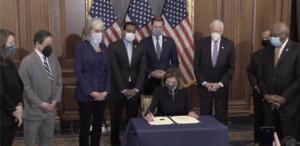
On January 11, 2021, an article of impeachment charging Trump with incitement of insurrection against the U.S. government was introduced to the House.[629] The House voted 232–197 to impeach Trump on January 13, making him the first U.S. president to be impeached twice.[630] Ten Republicans voted for the impeachment—the most members of a party ever to vote to impeach a president of their own party.[631]
On February 13, following a five-day Senate trial, Trump was acquitted when the Senate vote fell ten votes short of the two-thirds majority required to convict; seven Republicans joined every Democrat in voting to convict, the most bipartisan support in any Senate impeachment trial of a president or former president.[632]


